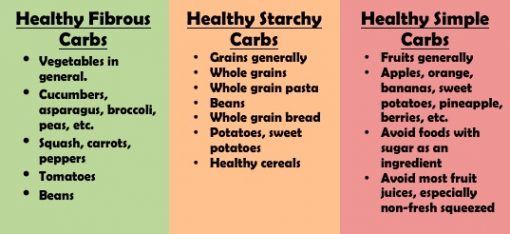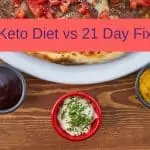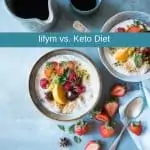Since both carb cycling and the ketogenic diet are relatively new diets to a large portion of people, there is a bit of confusion surrounding the difference between these two diets. This confusion is totally understandable though because both of these diets follow the eating style of keto as a base. Let’s get a better understanding of the differences between these two diets so we can see which one will be best for your lifestyle!
Topic Contents
Understanding Carb Cycling vs Keto
First – What is Carb Cycling?
Carb cycling is a great plan for people to follow if they don’t have large appetites and don’t easily give into cravings. While you are allowed to eat carbs while you’re carb cycling, eating healthy carbs will be the only way that you’re able to lose weight or achieve a healthier lifestyle. Eating bad carbs while you’re carb cycling is allowed, as long as it isn’t with every time you eat carbs.
In a personal belief, carb cycling is best left for people who are interested in bodybuilding or competitions. If you’re just looking to try carb cycling to lose weight, you will most likely struggle with making careful choices with your food selection. That isn’t to say that you’re going to fail at carb cycling if you aren’t a gym buff, but it does serve to be as a warning.
Depending upon what cycle you want to follow, carb cycling can be two different things. The first type of carb cycling you can follow along with is eating low carb meals and having two or three ‘cheat’ meals through the week that consist of higher carbs. Another option that you can follow along with is eating low carb all day and consuming the majority of your carbs during your last meal of the day. If you’re looking for a better explanation on the difference between these two cycles, read down below:
- Daily carb replenishing
If you follow daily carb replenishing, you will eat mainly proteins and fat throughout the day. However, when you’re consuming your last meal of the day, you will add in some carbs. Throughout the day your body will be running on ketones and will switch over to running on carbs during the evening.
- Weekly carb replenishing
Once a week (or even every few days), followers of carb cycling shift around their macros from around 80% and 5% carbs to 80% carbs and 5% fat. There are some people that will follow this throughout the entire day or simply just do this with their last meal of the day.
What is carb loading?
If there comes a time where you know you’re going to be putting out a lot of physical effort, you load up on carbs in advance. Followers of the carb cycling diet swear that this provides them with tons of energy to be able to complete difficult physical tasks. However, the followers of the keto diet say that if you just up your fat intake by eating peanut butter or coconut oil, you will receive the same energy benefits.
Carb Cycling – About the Diet
Many people find that they are faced with a reduction in carbohydrates if they want to lose weight. The thing is that carbohydrates are not all bad for you. In fact, some of them are good for you. They are going to help fuel your body for intense workouts and give you enough fuel to have the energy for your entire day. When you eat carbs, you replenish both glycogen and glucose. This helps you to feel great while preventing fatigue.
Even though carbohydrates can be good for you, carbs are not something that you have to have in your diet or that you have to have to live. However, we can all admit that they do make life just a little bit more enjoyable and they sure do make sticking to a plan easier. The biggest mistake that people make is that they eat carbs at the wrong time. This causes these carbs to be converted to fat and stored in the body as fat.
If you choose to use the carb cycling method, you are going to enjoy all of the benefits that this macronutrient has without any of the negative side effects. You will not gain or add fat to your body. This is a great way to approach weight maintenance or weight loss.
A Quick Look at the Plan
The first thing that you should know is that carb cycling is just staggering with the number of carbs that you eat in a day. Some days you get to eat more carbs, but some days you restrict and eat hardly any. This allows you to have the best benefits of the carbs on some days and the benefits of not eating carbs on other days. It is really the best of both worlds.
How to Carb Cycle
One of the easiest ways to carb cycle is to eat low carb for three days. After this, you spend two days eating higher amounts of carbs. These lower carb days are going to aid in weight loss. These days will also help with overall insulin sensitivity. The higher carb days are going to help your body to recover. These are the days to hit your hardest workouts as your body will repair itself quicker. Thus, you will not have as many painful days or as much recovery time. This will support muscle growth.
Keep in mind that the type of carbs that you are eating is important as well. If you are eating fibrous vegetables, you can actually skip counting the carbs from them. This is because they contain so much fiber and they are not going to affect you as much. The things that will affect you are the starchy complex carbs that are in foods like sweet potatoes, so you have to count those.
Of course, it is a good idea to keep a journal, as with all diets, to help you chart your progress. This is going to remove any guesswork that you might have previously had. You are going to see exactly how your body responds to these tactics. This will allow you to adjust your diet accordingly so that you can be sure that you will have success.
How Many Carbs Can You Eat While Carb Cycling?
To figure out how many carbs you should be eating on the highest days of the plan, you can multiply your bodyweight by one or one and a half. This will be the number of grams of carbohydrates that you can have. Many people choose to start with one and a half grams per pound so that they can adjust from there.
This method is likely going to take a little time while you learn about how your body works and processes carbs. This is where you are going to discover just how sensitive to carbohydrates you are. There are a few factors that you will want to consider while you are learning to adjust your carbs. How active you are, how intense you train, your age, and even if you are a man or a woman is going to affect how many carbohydrates you are going to get to eat. Most people do choose to start with around two hundred grams per day of carbs.
Sample Carb Cycling Plan
There are many ways that you can do your own carb cycling plan. The five-day carb cycling method using two hundred grams of carbs as the highest amount on a high day would look something like this:
- Day 1: 150 grams of Carbs
- Day 2: 100 grams of Carbs
- Day 3: 50 grams of Carbs
- Day 4: 125 grams of Carbs
- Day 5: 200 grams of Carbs
The mathematical equation is really simple for carb cycling. You basically drop fifty grams of carbs each day for the first three days. Then you will increase by seventy-five grams of carbs for the next two days. This can all seem a little overwhelming.
When you lower your carbohydrates, you can increase the amount of healthy fat that you are eating. This keeps you from feeling sluggish or tired as the fat will work to fuel you and make up for any loss of calories that you might have. Healthy fats are a dense calorie macronutrient which is why this can work to help you maintain optimal results and great health.
You do not have to increase your fat intake. If you follow this rule, you are going to burn more fat as fuel on these lower carb days. This will be especially true if you are cutting calories, doing cardiovascular workouts, or even just training hard. This all means that you will lose more weight if you do not increase your fat intake.
How Does the Body Burn Fat When Carb-Cycling?
Of course, you will want to understand how the body burns fat if you are using the plan for weight loss. On the days where you eat lower carbs, your body will burn more fat which will cause you to lose more weight. Lowering these carbohydrates is not just going to aid in weight loss, but it will also make your body more sensitive to insulin. This makes you have a lower body fat percentage naturally by helping to maintain better body composition.
High carb days are days when your body burns more calories. This is caused as the body sees an increase in leptin. Leptin is the hormone that keeps you from being hungry. These two both effectively prevent the low carb days from causing your metabolism to stall. This often happens with prolonged exposure to one diet. You will keep losing weight the entire time that you are carb cycling and there is science behind that!
What You Should Do When You Reach the Dreaded Plateau
Everyone eventually reaches a plateau where the fat burning stalls. This is the time in which you are going to have to switch things up. What this means is that you will change to where you have three or four higher carb days in a row. Another method is to eat two low carb meals and then to have one cheat meal each day. This is going to help you to restart your metabolism which helps you to resume the body’s ability to burn fat.
If this doesn’t work for you, attempt to try to eat even fewer carbs for a few days. This is where you go into a three day period with the goal of having zero carbs on those days. You can eat fibrous vegetables during these days as they have zero net carbs which are fine for your zero calorie days.
Just remember that you do not want to stay at zero carbs for longer than three days. You will never go below fifty carbs per day throughout the rest of the diet. This is really important. This is because if you continue going with too low of carbs, you are going to have issues with focus and might even feel as though your brain is foggy or cloudy. Your body actually needs a certain number of carbs to be able to fully function properly.
What Type of Carbs Should You Be Cycling?
There are a number of things that you will want to consider when you are using carb cycling. The first is that you need to make sure that carbs are coming from clean food sources, you should avoid all junk food carbs. This means that you are eating the majority of your carbs from whole food sources. You just need to eat most of your carbs earlier in the day. Then you can lower the number of carbs that you are eating as you go throughout your day. Do not think about the glycemic index of foods, but instead just focus on your total carb intake and how you are going to consume those carbs throughout the day.
Foods to Eat While Carb Cycling
There are a lot of different sources of carbs that you could be consuming. Understanding exactly what carbs to eat is important with carb cycling and will help you to have the most success.
Clean Carbs
You want to make sure that you are eating the best types of carbs and that you include these in your meal plans while dieting. In general, these are the best sources of carbs to eat:
- Sweet Potatoes
- Baked Potatoes
- Grits
- Oatmeal
- Rice
- Cream of Wheat
- Bananas
- Apples
- Corn
- Squash
- Peas
- Rice Cakes
- Berries
- Quinoa
- Beans
Simple Carbs
You want to make sure that you do not eat too many simple carbs and that you are not eating them at the wrong time. The best time to eat simple carbs the only time to eat simple carbs is when you have just gotten done with an intense workout. This is because you are going to be able to increase your carbs and have a higher level of success. A great rule of thumb is to have a delicious whey protein shake immediately after working out. Just make sure that your shake has fifty grams of dextrose.
Make sure that you are adding these carbs into the daily total, even though they are being processed immediately and efficiently by the body. They are still carbs that you have to count!
Junk Carbs
Junk foods that are full of sugar are always bad. They really have no place in any diet, even those who are not carb cycling. If you want to lose body fat and keep it off, then you have to stop junk food. While this might seem like a lot to ask, it is well worth it because you are not going to slow down the body’s ability to lose fat unless you are eating these bad highly processed foods.
Just by cutting back on junk food, you will find that you feel better. When you eventually have them completely limited, except for the rare occasional treat (think once every two weeks or less) you are going to find that you have an overall ability to lose more body fat and keep it off. This is going to have a number of health benefits on top of the fact that losing weight and maintaining a healthy weight are going to be easy.
One way to easily get the junk food out of your life is to start cutting back slowly. The thing that works the best for many is to think about different categories of junk food and cut back on one category at a time…slowly. You will want to go slow so that you train your body not to want these foods. Then you can move on to the next category. If you do this over a period of time, even if it takes you a complete year, you are going to think yourself in the end, and it won’t feel as painful.
Stay Focused on the End Goal
All of the time, you are going to hear the phrase “you can have anything in moderation.” This phrase is annoying in itself, but when you are dieting, it can be downright maddening. If you are too strict and you deprive yourself, you are less likely to stick to a diet. Well, at least that is what this statement claims. We are going to tell you that this statement is wrong. Actually, dieting is wrong. You do not want to ever go on a diet. Instead, you should be focused in changing your life and in maintaining a lifestyle that you can live with.
If you want to lose weight or even just maintain a healthy weight without dieting, carb cycling is one of the best lifestyles to consider. There are some goals that carb cycling can help you reach. If you want to see muscle growth and have an upcoming bodybuilding competition, carb cycling is for you. If you want to lose body fat percentage, lose weight, or even just maintain your weight, carb cycling for you. In fact, carb cycling is really for everyone!
The Dos and Don’ts of Cheating
Every singlet diet article that you are going to read (even this one) will have words like “cheat day” and “cheat meal,” so let’s take a moment to explore this concept and discuss what the dos and don’ts of cheating.
Do:
- Add days where you eat higher amount of carbs.
- Have occasional cheat meals, but keep it within reason. Most people simply do not realize that you can actually cheat enough in one day to negate an entire diet plan.
- Make sacrifices.
- Give up all unhealthy eating habits.
- Always eat clean, even on the cheat days!
- Have a good mindset.
- Keep yourself in check. If a cheat meal throws you off for a week, know that this is a cheat meal that you simply cannot have.
- Avoid all junk food!
Don’t:
- Allow cheat meals to be junk food meals.
- Eat processed foods, EVER!
- Jump off of clean eating on cheat days.
- Be upset, angry, or sad with having to eat clean.
- Let yourself get stuck in a struggle because of cheat days.
What are the pros of carb cycling?
If you are someone who has the ability to follow along with meal planning, following carb cycling could be very useful to you. Consuming higher carb meals are you complete high-intensity workouts will help you replenish the glycogen stores that you burned through during your workout. This means that you can eat higher carb meals and not have to worry about fat gain, as your body will use the glycogen in the higher carb food that you eat after your workout to replace its stores, instead of storing it as extra energy.
Maybe you are someone who enjoys dieting but wants to have a meal (or a few) to look forward to during your week. Following along with carb cycling may give you a few meals to look forward to during your week.
What are the cons of carb cycling?
A big problem that a lot of people have with carb cycling is people allowing themselves to consume ‘cheat’ food. When people are around these ‘cheat’ foods that high in both carbs and fat, they tend to over eat. By over eating on these high carbs, high fat ‘cheat’ foods several times a week, users will find that they begin to gain weight rather than lose weight.
If you know that you are someone who will fall into a pattern such as this, sticking to a consistent diet that allows to gradually adjust your carb intake. If you do choose to follow along with carb cycling, try eating carby foods that you know won’t trigger you to overeat!
Who should try carb cycling?
If you are someone who has problems with imbalanced hormones, adrenal fatigue, metabolic derangement, hyperthyroidism, or hypothyroidism, replenishing your carb stores will most likely do your body good. Try eating carbs at your evening meals or every couple of days to see how your body feels.
Healing your body should be important to you, especially if you are suffering from a medical condition. By eating carbs every few days or every evening, you’re providing your body with access to more nutrients, especially when you eat higher carb veggies.
Overall Results and Impressions
We have been able to see amazing results in both men and women with carb cycling. There are many reasons that we suggest this as a way of life for those who are fully in control of their diets. That being said, carb cycling is not for everyone. Some people find it way too hard to manage and end up struggling when they do not see success. No matter what lifestyle eating plan you choose, you are going to have to find the one that is going to work for you honestly, and either option in the carb cycling vs keto debate will work wonders!
What is the ketogenic diet?
The ketogenic diet is a high fat, moderate protein, low carbohydrate diet that was popularized as a non-medicated way to help treat epilepsy. As it’s gained more popularity, fitness experts and body builders have sworn by the diet for both health and overall wellness purposes.
When you limit your intake of carbohydrates, your body will enter a state of ketosis once your glycogen stores have run low. Once your body has run low on its glycogen stores, it begins to run on fat stores to use for energy; during this process, ketones are created in order to prevent your body from eating away at your muscles.
In a short explanation, once you limit your intake of carbs, your body will start to produce ketones and start running off of fat for energy. In order to stay in ketosis, users should consume high-fat proteins such as bacon, eggs, oily fish, red meat, and cheese to help keep their body in ketosis.
How Does the Ketogenic Diet Work?
The ketogenic diet works because you are consuming less than fifty grams of carbohydrates each day. While you are doing this, your body is going to run out of blood sugar quickly. This means that it is essentially out of fuel. Now, you do not have to worry about feeling sluggish or tired (well, at least not after the initial keto flu) because your body is going to quickly convert to using fat as its main source of energy. In fact, the body will actually transform quickly. The typical period for the body to reach ketosis is just three or four days. Once this happens, fat is going to be broken down into energy. This means that you are going to lose weight. The entire process is referred to as ketosis.
Who Can Use the Ketogenic Diet?
The ketogenic diet is a great choice for people who want to lose weight. It is a diet that anyone can use and is a diet that works for both men and women and those who are young and old. Overall, it is a new lifestyle that anyone (even children) can adapt to and in the end feel healthier for having adapted to it.
In addition to those who are seeking weight loss or optimal health, people who have certain medical conditions often find health benefits from the ketogenic lifestyle.
Some of these medical conditions include:
- Epilepsy: People who have epilepsy might actually find that they have a reduction in the number of seizures that they have. Some even had a full fifty percent reduction, just with changing their lifestyle to this plan.
- Heart Disease: Those suffering from heart disease will find that this plan can help them. Some have even been able to go off their medications (while working closely with their physician) as the ketogenic diet will help them to have higher levels of healthy cholesterol and lower levels of unhealthy cholesterol.
- Brain Diseases: There are a number of brain diseases that can have a decrease in signs and symptoms when you are eating the keto lifestyle plan. This means that your brain is being fed more regularly and that you are not ever having those cloudy or foggy days. The main reason for this is that the body can fuel the brain better when it consumes a higher fat content in natural foods.
- Acne: People who eat the ketogenic diet notice that their skin looks healthier. They will have a reduction in acne and overall have healthy and clear looking skin.
- Type II Diabetes: (WARNING: If you have Type I Diabetes do not start the ketogenic diet or attempt the ketogenic diet without first gaining approval of your physician. You will have to maintain regular appointments and follow-ups to monitor the success of the ketogenic lifestyle and to ensure that you are able to maintain your health.) For those who have Type II Diabetes, this lifestyle choice can help you to maintain optimal health and keep your blood sugars stable and controlled.
Some of these will be explained in more depth. This will allow you to understand just how powerful the ketogenic diet can be for the body.
Top Reasons to Get on the Ketogenic Diet
The ketogenic diet has a lot of positive effects on the body. These include the following but are not limited to them.
Weight Loss and the Ketogenic Diet
Perhaps the biggest reason that the ketogenic diet is becoming so popular is that it is an excellent choice for optimal weight loss. In fact, some people lose more weight in three months with the ketogenic diet than others can lose in an entire year. Of course, the biggest thing to remember with this is that if you are not planning on sticking to the ketogenic lifestyle, you are likely to gain back some of the weight if not all of it. In fact, there is even the possibility to gain back all of the weight and more. The ketogenic should be a full lifestyle change if you want to have success with long-term weight loss and/ or weight maintenance.
The ketogenic diet is going to help you out because the body actually burns more calories changing fat into energy. In addition to causing you to burn more calories, once the body is used to converting fat, it is going to start converting all of your stored fat. This ultimately leads to fat loss and weight loss.
Many people also report that they have fewer cravings and no hunger pains when doing the ketogenic lifestyle. This is because fat actually helps you to feel full longer, so eating high fat rarely makes you feel hungry. In turn, you actually end up eating less. Well, that is the theory and what dieters have reported. This is something that is currently being scientifically researched, so the overall consensus is that this is the case but it still needs to be proven.
The Ketogenic Diet and Cancer
Cancer is a major concern of many people. Those who have cancer or those who are in remission are likely to attempt to adopt a lifestyle that is going to help keep cancer cells under control and keep them from expanding throughout the body. We all have cancer cells in our body at all times. Many people do not realize this one small scientific fact.
What happens when you have cancer is that these cells are being fed at alarming rates and begin to take over the body, actually feeding off of the healthy cells. Sugars and processed foods allow for cancer cells to feed more easily, so eating a diet where you avoid these foods is a great way to reduce the overall effects that cancer can have on the body.
In addition, your body stores sugar to be used as fuel. Insulin is a hormone that allows the body to do this. When you are on the ketogenic diet, your body is going to fuel itself quickly from these carbohydrate sources. This means that you are not going actually to have to store these carbohydrate sources in the body. Ultimately this leads to the body needing less insulin. These lower levels of insulin are additional protection against some types of cancer. Research has also shown that cancer cell growth is slowed with lower levels of insulin.
There still needs to be more research on the ketogenic diet and its effects on cancer as not much has been done.
Heart Disease and the Ketogenic Diet
Heart disease is one of the main killers of women and men in America. This is scary because it might feel like heart disease is completely unavoidable with the typical American diet. Many people automatically associate a low-fat lifestyle with heart disease, but this does not have to be the case. In fact, having heart disease calls for more fat which can essentially raise the levels of good cholesterol and lower the levels of bad cholesterol. This is exactly what the ketogenic can do for your body.
While research has not been done on this subject, or at least results are not readily available, the ketogenic diet allows you to lower the levels of insulin in your body. When you lower your levels of insulin, your body stops making cholesterol. This means that you are going to be able to lower your blood pressure, see a reduction in hardened or clogged arteries, reduce your risk of heart failure, and lower your risk of multiple additional heart conditions. In short, you are less likely to have a heart attack while living the ketogenic lifestyle.
What are the pros of the ketogenic diet?
One of the biggest pros of the ketogenic diet is the ability this diet has to help fight Type II diabetes. Since suffers diabetes suffers from an increased production of insulin, the ketogenic diet removes sugars from your diet, which will help to lower your A1C count. If you follow along with the ketogenic diet for a long enough time, you could effectively reverse your Type II diabetes.
Some of the other added benefits of following the ketogenic diet is increased energy levels, increased mental clarity, and increased stamina, on top of the weight loss that users experience while following the ketogenic diet.
What are the cons of the ketogenic diet?
People who have not ‘stepped down’ into the ketogenic diet, you may find that you will feel tied and that you have less endurance for a few weeks while your body is getting used to the diet. In other words, if you go from a high carb diet into the extreme low carb diet that ketogenic diet is, you will find that your body will feel worn and tired for a few weeks until it gets used to running on fat for fuel.
Also, the ketogenic diet is a very restrictive way of eating. There are a lot of foods that a person cannot consume if they’re looking to keep their body in a state of ketosis. It can be extremely difficult for some people to closely monitor their meals and snacks to ensure that they’re consuming enough fat, not too much protein, and not too many carbs to ensure that their bodies stay in ketosis.
Overall Results and Impressions
We have noticed that many people have great success with the ketogenic diet. It, of course, needs to be a lifestyle change and not just a diet. Those who use it as a diet have negative effects when they are no longer eating this way. This leads to an increase in weight and an even higher percentage of body fat. However, for those who truly use this as a lifestyle change the benefits are outstanding. They are able to easily lose excess weight and maintain their body’s optimal weight. They report not feeling hungry and that love that they have all of the energy that they need.
Carb Cycling vs Keto – Conclusion
As always, you should consult your doctor before you make any huge changes in your diet. Depending upon any medical conditions you have, you may or may not experience adverse reactions to either one of these diets. Even if you do not suffer from any medical conditions, you should complete some additional research on either carb cycling or the ketogenic diet to see if either of these diets would truly be beneficial to your lifestyle and your health.
Comparing these two diets and the benefits that they provide will really just matter depending upon the person looking at the two diets and the lifestyle that they lead. The difference is really up to you on whether you want to stay in full ketosis or if you want to follow with carb cycling. Every person has a different body, so what works for you may not work for someone else. Try out a few different options and listen to your body. The only way that you’re going to know what works well for your body is by listening to and observing the way your body reacts to the changes you’re making.
Further read,
- Clean Keto vs Dirty Keto Compared
- Gluconeogenesis vs Ketogenic: What Happens When You Reach Ketosis?
- The Ultimate Best Keto Foods List
MEDICAL REVIEW COMMENTS FROM DR. ROBIN WALSH, BASC, ND
I tend to agree with the authors personal perspective on this one, and say that I also feel that people have to be careful with carb cycling when it comes to weight loss. Don’t get me wrong, I do incorporate this approach with some of my patients but it tends to give better results to those that are doing weight training. I also tend to incorporate some of these ideas when people get to the weight maintenance phase of their program. The daily carb replenishing idea is great for those people that have stabilized their hormones are are looking for weight maintenance. I tend to find that putting in carbs at night is the most sustainable for people as they can eat what everyone else in their family is eating. I also find that since carbs increase serotonin they are helpful at night to help people sleep.
When people are struggling with weight loss, or have hormonal imbalances such as diabetes, insulin resistance or PCOS they tend to do much better at least in the beginning with a plan such as a low carb or ketogenic with some intermittent fasting. Once the hormones have stabilized and weight loss has been initiated these carb plans are lovely to transition to for maintenance.
Disclaimer
Last updated: December 16, 2019
The information contained on www.altprotein.com website (the “Service”) is for general information purposes only.
Alt Protein assumes no responsibility for errors or omissions in the contents on the Service.
In no event shall Alt Protein be liable for any special, direct, indirect, consequential, or incidental damages or any damages whatsoever, whether in an action of contract, negligence or other arising out of or in connection with the use of the Service or the contents of the Service. Alt Protein reserves the right to make additions, deletions, or modification to the contents on the Service at any time without prior notice.
Alt Protein does not warrant that the Service is free of viruses or other harmful components.
Fitness disclaimer
The Service offers health, fitness and nutritional information and is designed for educational purposes only. You should not rely on this information as a substitute for, nor does it replace, professional medical advice, diagnosis, or treatment. If you have any concerns or questions about your health, you should always consult with a physician or other health-care professional.
Do not disregard, avoid or delay obtaining medical or health-related advice from your health-care professional because of something you may have read on the Service. The use of any information provided on the Service is solely at your own risk.
You can also review our Editorial Integrity Policy.
Alt Protein Team is a team of professionals and enthusiasts committed to bringing you the most up-to-date information on alternative protein, health and wellness, workouts, and all things health-related. We’ve reviewed a lot of products and services so you don’t have to guess when you spend your hard-earned money on them. Whether you want to shed some pounds, build lean muscle or bulk, we can help you figure out what you need to do and what you need to have to achieve your goals.


















